 This is the tale of two looms and a 19 year old who was into me for $300. The reason he was into me for $300. isn’t important, but as he is trying to work off this rather cumbersome debt, I’m trying to think of things for him to do besides clean my house thoroughly, which he has already done. I was going to set him to work on the outside gardens today, but alas, it has poured rain steadily through the entire day. So, that leaves something for me to invent for him to do in the studio. Enter two small Structo looms I acquired on my travels. The one on the right is an eight shaft, which had been refurbished, the finish is awful, but all the parts are there and in working order, except the aprons are cut way too narrow for the already narrow little loom. (For the non weavers, the aprons are the white cloth on the front and back beams that attach to the warp and the finished cloth.)
This is the tale of two looms and a 19 year old who was into me for $300. The reason he was into me for $300. isn’t important, but as he is trying to work off this rather cumbersome debt, I’m trying to think of things for him to do besides clean my house thoroughly, which he has already done. I was going to set him to work on the outside gardens today, but alas, it has poured rain steadily through the entire day. So, that leaves something for me to invent for him to do in the studio. Enter two small Structo looms I acquired on my travels. The one on the right is an eight shaft, which had been refurbished, the finish is awful, but all the parts are there and in working order, except the aprons are cut way too narrow for the already narrow little loom. (For the non weavers, the aprons are the white cloth on the front and back beams that attach to the warp and the finished cloth.)
The second loom was also given to me, and all the pieces to it are sort of there, but many of the cross pins are missing and the loom frame had some creative copper beam replacements. This loom also had a hex warp beam with four two inch spools that fit snugly on the hex beam, and held a lot of fine warp. I unreeled one of the spools and pulled off about 20 yards. That’s a lot of warp for such a tiny loom.
 I want to set up one of these looms to make more of the little Personal Post series postcards, I’ve had some luck with in exhibits. The cards themselves are only about 6 x 4″, so having an 8″ wide loom, with a long warp on it should let me weave for awhile and see what I can come up with, without tying up my larger looms. And the way they were perched on top of two spool racks as you entered my studio made for some dangerous snowball effects when one or both of them caught on someone’s clothing and went careening off their perch. But I digress…
I want to set up one of these looms to make more of the little Personal Post series postcards, I’ve had some luck with in exhibits. The cards themselves are only about 6 x 4″, so having an 8″ wide loom, with a long warp on it should let me weave for awhile and see what I can come up with, without tying up my larger looms. And the way they were perched on top of two spool racks as you entered my studio made for some dangerous snowball effects when one or both of them caught on someone’s clothing and went careening off their perch. But I digress…
I technically only need four shafts for the structure for the post cards, it is a Theo Moorman inlay, with two shafts for the ground, and two shafts for the tie-down threads. The problem is I need a lot of heddles. And as far as I know, Structo heddles are no longer made. Someone please tell me if I am wrong on this… Between the 12 shafts I have on the two looms, I have enough heddles for the job, and I can use 4 shafts for the ground instead of two, because I can. So enter my 19 year old. His assignment once he rolled out of bed at noon, was to dismantle both looms, and keep the best parts, and transfer 60 heddles to each of six shafts. Here’s the thing. Heddles, those little wire things with eyes, where each warp thread is threaded through, all have to face in the same direction. Or anyway in the perfect world they should. Older looms, where heddles have been added and taken away, tend to have a mismosh of heddle directions which is a pain in the neck to thread. So he worked for about an hour and a half, creating for me a nice eight shaft loom with lots of heddles, all going in the same direction.
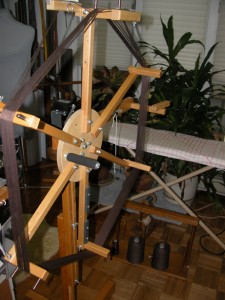
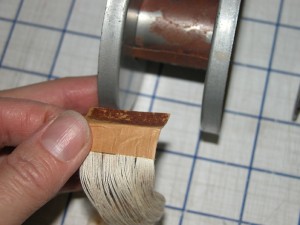 Meanwhile, I pulled out the AVL warping mill to see if I could figure out how to wind warp on those little spools that fit on the hex beam. First the math. The Structo reed is a fixed 15 dent. The thread I pulled off the spools, was pretty close to a 20/2’s cotton, which is pretty fine. And from the quick count I did, they used that thread sleyed double through the reed, at 30 ends per inch. What I couldn’t figure out was how to put the warp on the spools to begin with. So I unwound each of the spools, like peeling paint off a house, there must have been about 20 different warps tied end on end. I got to the end of the spool, and found that the ends of the warp were all glued to some kind of paper tape that then inserted into a metal flange and the way the beam was wound, kept the paper from pulling out.
Meanwhile, I pulled out the AVL warping mill to see if I could figure out how to wind warp on those little spools that fit on the hex beam. First the math. The Structo reed is a fixed 15 dent. The thread I pulled off the spools, was pretty close to a 20/2’s cotton, which is pretty fine. And from the quick count I did, they used that thread sleyed double through the reed, at 30 ends per inch. What I couldn’t figure out was how to put the warp on the spools to begin with. So I unwound each of the spools, like peeling paint off a house, there must have been about 20 different warps tied end on end. I got to the end of the spool, and found that the ends of the warp were all glued to some kind of paper tape that then inserted into a metal flange and the way the beam was wound, kept the paper from pulling out.
I dug around in my vast archives of stuff, and found my roll of paper tape, and grabbed the two cones I bought of 14’s linen, (from my trip to Silk City a couple weeks ago), which appeared to be pretty close to a 20/2 cotton, and a small cone of brown serger thread that matched pretty well. The serger thread is finer than sewing thread, and works well for the tie down yarns.
OK, I’ve never done something like this before, I use my AVL warping wheel for winding sectional warps. It came with a 20 dent reed, which is really odd, who uses a 20 dent reed, or so I thought at the time. Turns out that the actual space in each spool is 1 1/2″, and 30 dents in a 20 dent reed is 1 1/2″. How cool is that? (If you aren’t a weaver and are reading this, I probably lost you back on the first paragraph. Sorry, but this is one of those posts that gets kind of technical so you may want to just look at the photos and tune in another time to see what I actually do with all this!)
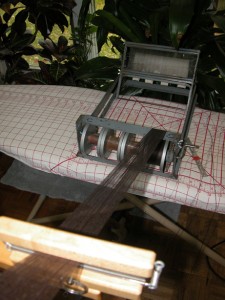
 So I wound my 2″ worth of linen/serger thread warp into the warping mill, using the 20 dent reed, which meant the real width here was only 1 1/2″. Then I beamed one of the spools directly off the AVL mill, right onto the back beam of the loom, which is missing its entire castle housing because my son has it apart on my cutting table. You can see the band of thread coming through the 20 dent reed. Each dent has two ends of linen and one end of serger thread.
So I wound my 2″ worth of linen/serger thread warp into the warping mill, using the 20 dent reed, which meant the real width here was only 1 1/2″. Then I beamed one of the spools directly off the AVL mill, right onto the back beam of the loom, which is missing its entire castle housing because my son has it apart on my cutting table. You can see the band of thread coming through the 20 dent reed. Each dent has two ends of linen and one end of serger thread.
I used the paper tape and glued it over the ends to start(it’s the kind you just lick, do they even make that anymore? It’s used for taping up boxes, you can see the little roll to the right of the loom.) The paper tape held the ends really well, keeping the order, and slipped into the flange of the spool and I just started winding. The warp went on like butter, smoothest thing I’ve ever wound. The 15 yard warp beamed in about 3 minutes. I finished winding the warp by putting a piece of the paper tape over the ends coming out of the reed on the AVL mill. That kept my thread order and allowed me to move on to the next spool.
Everything went well until I got to the last spool. 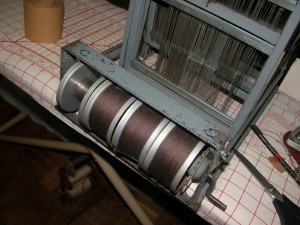
 There was plenty of linen, but the serger spool wasn’t looking like it was going to make it. Of course it was my only one, and as luck would have it, Coats and Clarks discontinued it’s Tru-Lock serger thread, replacing it with something else, which didn’t come in that color, Chona Brown.
There was plenty of linen, but the serger spool wasn’t looking like it was going to make it. Of course it was my only one, and as luck would have it, Coats and Clarks discontinued it’s Tru-Lock serger thread, replacing it with something else, which didn’t come in that color, Chona Brown.
I had overwound the first warp for the first spool by a half dozen dents, so I had pulled it off and tossed it in the trash. Realizing I was going to be really close, and might make it to within the last half inch of warp, where I don’t really need the tie down threads, I went into the trash and pulled out this mess…
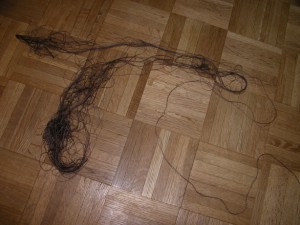 Actually, it was a lot worse, this was what was left after about an hour’s worth of work and having the dog come cruising through the little pile I’d pulled out of the serger thread. But perseverance is my middle name, after all I am a handweaver and that sort of goes with the territory. Most weavers I know would take a couple hours to undo a mess like this, and after the serger thread was pulled out and rewound onto the cone, I managed to squeak out the last warp spool on the loom with only the end 1/2″ with no tie down threads
Actually, it was a lot worse, this was what was left after about an hour’s worth of work and having the dog come cruising through the little pile I’d pulled out of the serger thread. But perseverance is my middle name, after all I am a handweaver and that sort of goes with the territory. Most weavers I know would take a couple hours to undo a mess like this, and after the serger thread was pulled out and rewound onto the cone, I managed to squeak out the last warp spool on the loom with only the end 1/2″ with no tie down threads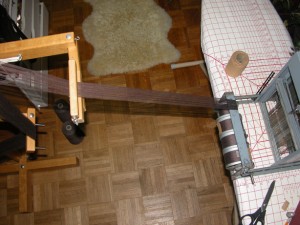 . Which is actually fine. The problem is, when I wound the last spool on the loom, the 1/2″ without the serger thread was on the inside not the outside of the spool. So I figured I’d have to do some creative threading, and maybe stretch some of the thread from other bundles, and anyway, it was time to make dinner.
. Which is actually fine. The problem is, when I wound the last spool on the loom, the 1/2″ without the serger thread was on the inside not the outside of the spool. So I figured I’d have to do some creative threading, and maybe stretch some of the thread from other bundles, and anyway, it was time to make dinner.
My lovely creative pink haired daughter came into the studio after dinner and asked her usual, “Watcha doin’?” I showed her my dilemma, and she said, rather annoyed, “Mom, just rearrange the spools on the beam…”
Boy did I feel stupid. So in about 15 seconds, I popped the four spools off the hex beam, rearranged the spools so the missing 1/2″ of tied down threads is now at a selvedge edge, and all is well.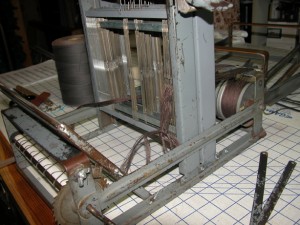
So, now I’m threading my loom, all the heddles are going in the same direction, and life is good. These little looms are a pain in the butt to thread, but I can put up with anything for 8″. I tossed out a 1/2″ of tie down threads on the opposite selvedge, so the two selvedges would match. I’m still not sure that the sett is appropriate for this fine yarn, in what I’m trying to do with it, but I won’t really know until I actually start weaving. So stay tuned!
If you want more information on the AVL warping mill, the AVL site has lots of information and I also cover it in my monograph, “Warp Fast”, which also covers sectional warping and warping with a paddle. The AVL warping mill works like a dream when winding the warping spools for the small Structo’s. And my little Leclerc Structo wannabee, that I’ve been using for the rug samples for the guild seminars, also has an additional hex beam with five warping spools on it for 10″ wide! Yippee! And I can more than likely get more heddles for the Leclerc.